The leadership challenge - the Prevent Duty for governing bodies and senior leaders in HE: notes for trainers
Published 1 April 2021
Applies to England
These training notes should be used in conjunction with the ‘The leadership challenge: the Prevent Duty for governing bodies and senior leaders in higher education (HE)’ PowerPoint presentation.
1. Note to the trainer
These training notes are intended to support HE providers delivering the ‘An introduction to the Prevent Duty in higher education (HE) PowerPoint presentation. It can be adapted by the provider and delivered to large numbers of staff.
These training materials are not intended to be a replacement of Home Office’s Prevent awareness training.
1.1 Top tips for delivering this training
- Apply the same principles you would to all training activities – know your audience, identify their training needs, plan your approach carefully, develop a communication plan so that staff understand the purpose of the training, and why they should engage with it.
- Be open and transparent - recognise that staff will have preconceptions and concerns about Prevent, draw these out and address them at the start of face-to-face sessions. This can work well as an icebreaker.
- Involve staff and students in discussions about training, working in partnership with staff and student representatives. Use both existing mechanisms (committees, staff-student liaison groups, departmental meetings, etc) and any Prevent-specific mechanisms in place.
- Think how you can use the expertise of other specialists in Prevent training – data protection and FOI officers, for example. Bringing in equality and diversity officers can help staff understand how Prevent interacts with equality and diversity legislation.
2. Outline
This training will identify what expectations are set for leaders of providers – executive and non-executive – in the general guidance on the duty issued for specified authorities in the Counter-Terrorism and Security Act 2015 (CTSA) (as amended), which is to have due regard to the need to prevent people from being drawn into terrorism, and in the Prevent Duty guidance for higher education providers in England and Wales.
Secondly, it will describe the Office for Students’ (OfS) monitoring framework, the monitoring authority for relevant higher education bodies (RHEBs) in England, which identifies the relative responsibilities of accountable officers and governing bodies, and OfS’ role in reporting to government.
The presentation is intended to provide an overview of the duties placed on leaders of providers for the effective implementation of Prevent.

Image of slide 1: Outline
3. Sector-specific guidance
Section 26(1) CTSA 2015 imposes a duty on specified authorities, when exercising their functions, to have due regard to the need to prevent people from being drawn into terrorism. This statutory duty is called the Prevent Duty. Certain RHEBs are subject to section 26 (the Prevent duty).
Implementation of the Prevent Duty has not been without its challenges. There are several practical considerations relating to the size, scale and overall purpose (including charitable purpose) of RHEBs which need to be taken into account.
Successful implementation of the Prevent Duty requires sound management, clarity on roles and responsibilities, supported by good processes and procedures.
Leadership is seen as vital for all specified authorities and, without effective leadership, the guidance implies that effective implementation of the duty will not ensue. Although the guidance identifies 2 other themes – ‘working in partnership’ and ‘capabilities’ – it assumes that these will not be delivered effectively unless they are included in the specific expectations of leaders and managers.
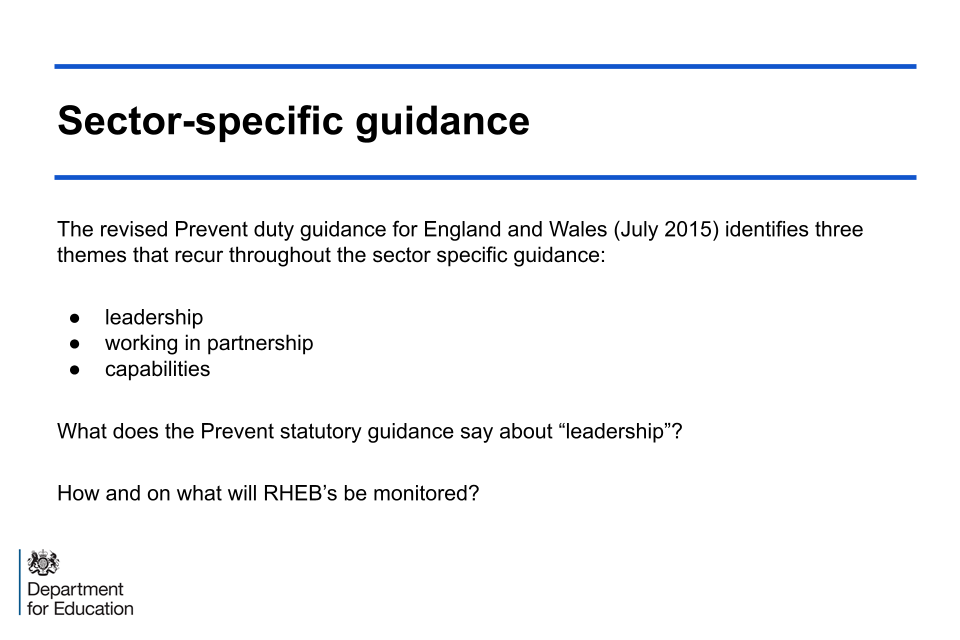
Image of slide 2: Sector-specific guidance
4. Expectations of those in leadership positions
These general expectations require leaders to ensure that, in the context of their own organisation, the risk of radicalisation of members of the organisation is assessed, widely understood by staff, and that staff develop the capabilities to deal appropriately with any risk. Leaders are also expected to communicate and promote the importance of the Prevent Duty so that staff can assume their own level of responsibility for implementing the duty.
The HE-specific guidance is very explicit in locating ultimate responsibility for implementing the Prevent Duty:
- for qualifying institutions (section 1 Higher Education Act 2004)
- the governing body
- private HE institutions, not in receipt of public money and with more than 250 students, the governing body or proprietors
This is, of course, the case with other legal responsibilities – including around academic freedom and freedom of speech, health and safety and equality and diversity.
It is well worth emphasising this point so that governing bodies (or a proprietor) acknowledge that Prevent should be regarded as an additional responsibility alongside other areas of legislation for which they are responsible. It is also worth emphasising here that for many providers the engagement with Prevent is longstanding.
The Prevent strategy dates from 2011, although providers will have varying degrees of experience in their engagement with Prevent, depending on their profile, geographical locations, and other factors. However, activity prior to 2015 may not have been labelled by settings as ‘Prevent’ specifically, but rather as part of their wider safeguarding, welfare and equalities work. The 2015 Act ensured that the sector had due regard to the need to prevent people from being drawn into terrorism - the Prevent Duty.

Image of slide 3: Expectations of those in leadership positions
5. What does this mean?
The key point here is that governing bodies (or a proprietor) must not only ensure that appropriate policies are in place but that they are properly followed and applied. This means that mechanisms and processes to achieve this are considered – effective auditing and reporting, for example, and always ensuring that the boundaries between executive and non-executive responsibilities and duties are maintained.

Image of slide 4: What does this mean?
6. Providing assurance
Governing bodies are required to provide an assurance to the monitoring body (the Office for Students (OfS) in England and the Higher Education Funding Council Wales (HEFCW) in Wales) to demonstrate that the relevant body is meeting the duty to pay due regard to preventing people being drawn into terrorism. Scotland and Northern Ireland have devised their own monitoring arrangements. Although boards provide assurance across a range of areas – proper use of public funds, accuracy of data returns, financial controls and value for money, academic standards and quality of academic provision – the responsibility to provide an assurance on meeting the Prevent Duty is also a specific necessity.
Providers generally have to submit more detail on Prevent than in these other areas, reflecting the information that OfS and HEFCW require to provide them assurance that the sector is actively implementing the Duty.
This establishes the expectation of active engagement at the highest level and signifies that providers will work in partnership with local and regional Prevent teams at a sufficiently senior level.
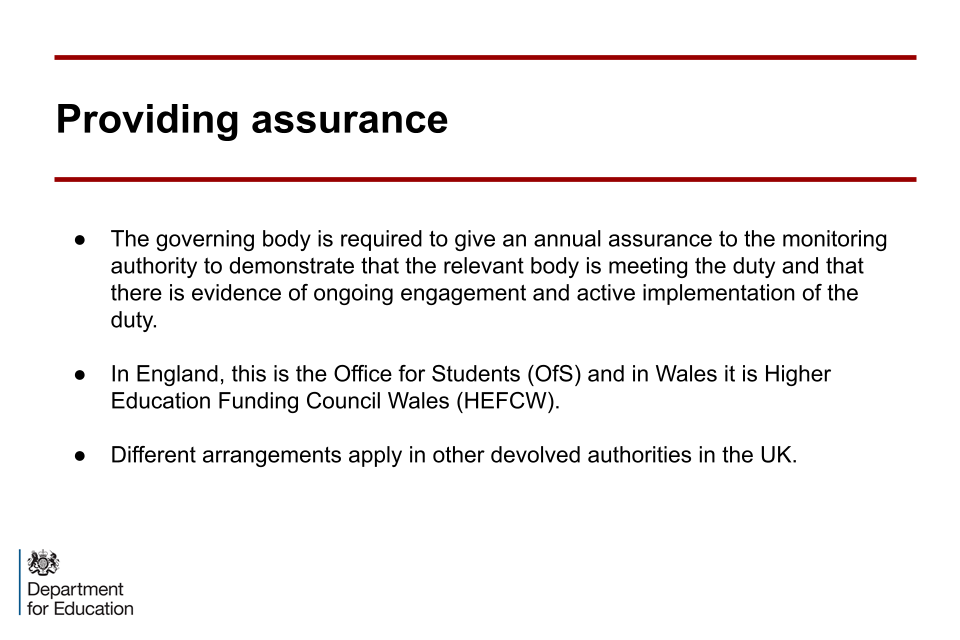
Image of slide 5:Providing assurance
7. Effective delivery: part 1
These slides summarise the areas where leaders will need to ensure effective delivery if the Prevent Duty is to be properly discharged - they correspond with the descriptions in the statutory guidance itself and they also inform the monitoring framework. They include developing effective internal and external partnerships to provide:
- effective risk assessment
- action planning
- effective training of staff that is proportionate and targeted
Leaders will need to consider carefully how to:
- consult effectively with students
- uphold academic freedom and freedom of speech, which are fundamental to HE (the Duty acknowledges this)
- avoid conflict with other important legal responsibilities, especially data protection (including GDPR) and the 2010 Equality Act (again the Duty acknowledges this)
- implement sensible IT policies that protect computer systems but do not constrain research, learning and teaching
- ensure that pastoral care arrangements provide mechanisms to support students at risk of being drawn into terrorism
For most providers, executive leadership will be delegated by the senior members to a senior executive colleague.
As a result of the heightened public concern about extremism and terrorism, and the detailed nature of the responsibilities placed on the higher education provider under the Prevent Duty, it is crucial that these delegated responsibilities are clearly articulated. Higher education providers are strongly advised to appoint a senior level Prevent lead, and an institution-wide Prevent steering group (which may be embedded within an existing safeguarding or welfare board), which the Prevent lead chairs. In deciding how executive responsibility should be assigned, universities may wish to consider that while the safeguarding of students is likely to be a major element of a provider’s Prevent action plan, the Prevent Duty touches on all aspects of a university’s activities – research, teaching and enterprise – and impacts on all stakeholder groups.
The Prevent Duty guidance makes clear that the statutory duty needs to be discharged “in the exercise of [a provider/RHEB’s] functions”. This means that the intention is for the duty to be normalised, embedded within existing responsibilities and processes. Hence the RHEB’s Prevent lead should have a good overall grasp of the various functions on which Prevent compliance impacts.

Image of slide 6: Effective delivery (1 of 2)
8. Effective delivery: part 2
Most importantly, the Prevent lead needs to be a person of sufficient seniority, who commands respect among both academic and administrative staff, and preferably with the student body as well.
One of the key challenges for the Prevent lead is how to communicate the purpose of Prevent effectively and persuasively; how to discharge the institution’s obligations in such a way as to meet the requirements of the duty on the one hand; and how to minimise any inadvertently adverse impacts on the core purposes of the institution on the other.
If poorly implemented, the duty has the potential to impact negatively on the fundamental academic character of the institution and cause disharmony within the institution, which itself can be particularly damaging to the shared endeavour of learning, teaching and research.
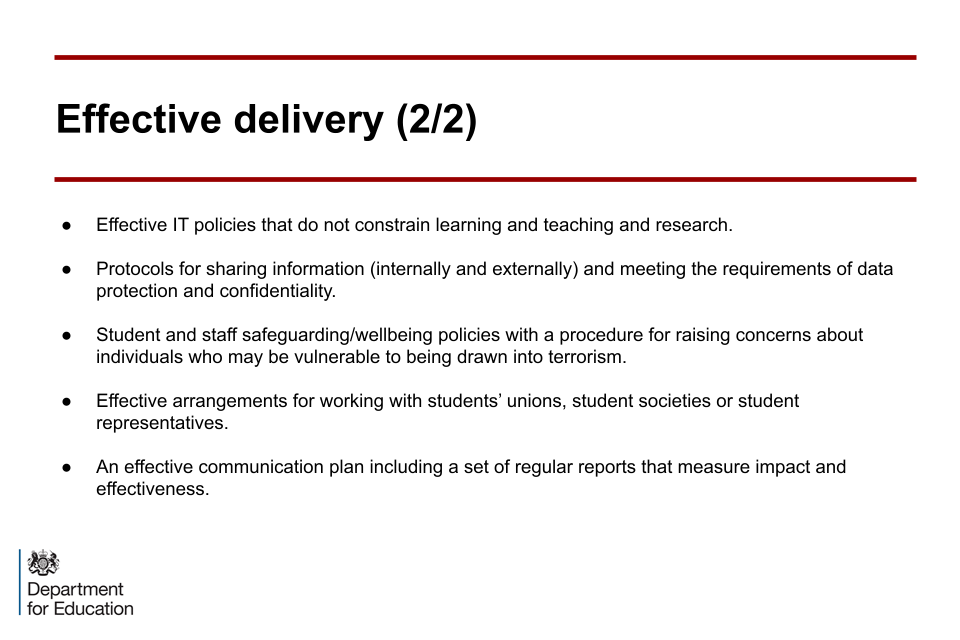
Image of slide 7: Effective delivery (2 of 2)
9. The monitoring framework – England
The original monitoring framework was published in December 2015, setting out how it will gather information from relevant higher education bodies (RHEBs) to demonstrate to government that the HE sector is compliant with Prevent.
The latest framework by the OfS (published in September 2018) has moved to a more evidence and risk-based approach to monitoring.
The other devolved authorities in the UK have devised their own monitoring arrangements.
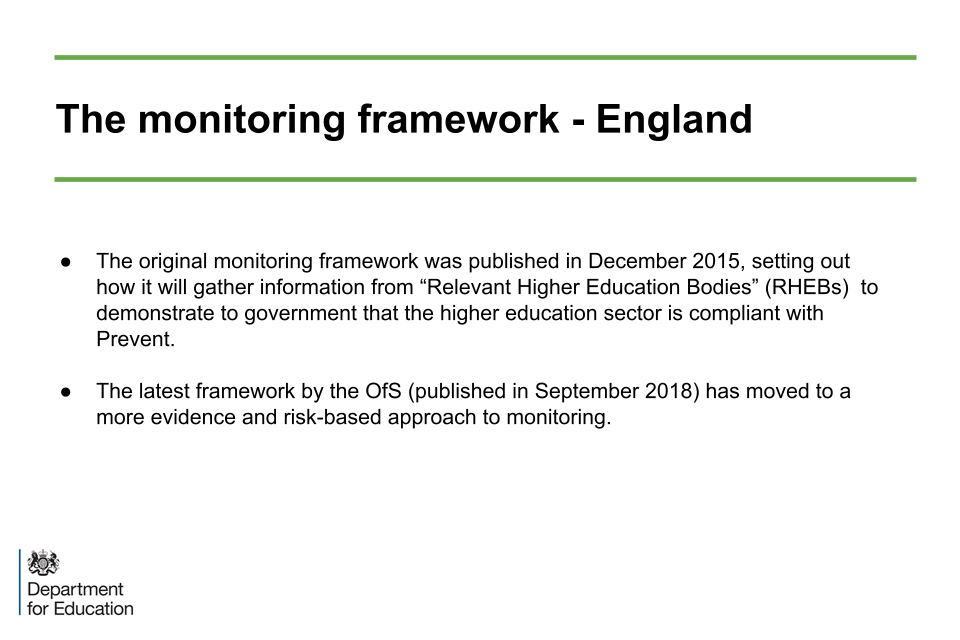
Image of slide 8: The monitoring framework - England
10. Providers registered with Office for Students (OfS)
These slides identify Office for Students (OfS) as the monitoring authority for over 300 providers in England across 4 distinct groups:
- providers that are registered with the OfS
- providers that are not registered (do not receive public funding) but have more than 250 HE students (the majority must be on campus and not remote)
- providers that are designated for student support by the Secretary of State (for example, for the purposes of ‘teach out’)
- the autonomous colleges, schools and halls of the Universities of Cambridge, Durham and Oxford
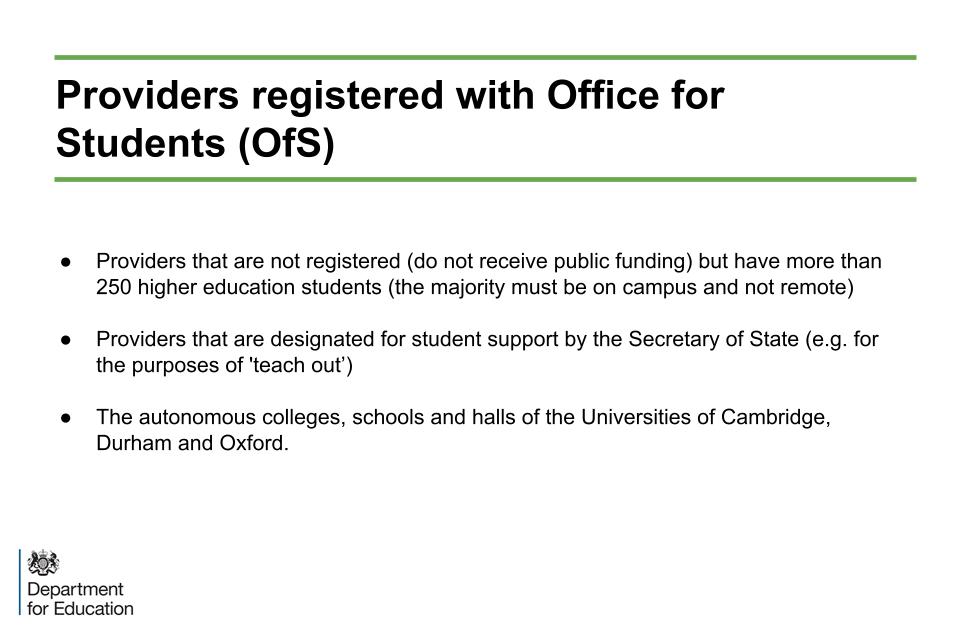
Image of slide 9: Providers registered with Office for Students (OfS)
11. OfS requirements
This slide describes the phased approach taken by the OfS to monitoring activity since the Duty came into force in 2015.
The OfS has worked with those providers that have required further support or action to bring them up to a satisfactory level of compliance. Read OfS’s ‘Counter-terrorism - the Prevent Duty’ for further information on levels of compliance at sector level, progress against the individual elements of the statutory guidance and core themes from each monitoring phase.
Providers will be assessed as having ‘due regard’ to the duty if they satisfactorily demonstrate that they have both appropriate policies and processes in place in response to the Prevent statutory guidance, and are following these policies and processes in practice.
The governing body, and the chair of the governing body in particular, must be made aware of the compliance requirements associated with Prevent. The OfS’ latest Monitoring Framework (2018 onwards) sets these out, which is predominantly:
- the annual accountability and data returns
- Prevent review meetings
- ensuring the OfS are informed regarding any material changes to policies, changes in circumstances and any serious Prevent-related incidents
In the case of small or specialist providers, the responsibility for governance oversight rests with the proprietor. Vice chancellors, principals or chief executives are expected to understand the nature of the Duty, to own the Prevent risk assessment for their institution; and to set the leadership tone for the implementation of the Duty in their institution.

Image of slide 10: OfS requirements
12. Serious incidents and material changes
This slide refers to Prevent reviews and how they will be triggered and the responsibility for providers to report to the OfS serious incidents and material changes; it gives examples of the types of incidents and changes that might be reported. We expect governing bodies to be appraised of any serious Prevent-related incidents reported to the OfS, and to be assured appropriate steps are being taken to address any concerns.
Prevent reviews may be triggered where there are concerns about information provided through annual reports (or lack of evidence); serious incident reports by the provider or a third party; previous Prevent concerns that have not been fully addressed; significant concerns raised by substantial changes to major Prevent-related policies; and to new entrants to monitoring.
They will be used to explore further the providers’ understanding of and approach to the duty and gather further evidence including stress-testing key policies or discussing lessons learnt as a result of a serious incident, for example. It is for providers to decide what constitutes a serious Prevent-related incident, but this might include anything which causes a significant review of Prevent policies or which could cause reputational damage because of adverse media reports.
The OfS will also ask providers for reports if they are made aware of anything significant by third parties or via media reporting. “Material changes” relate mainly to changes in responsibility for Prevent and in governance arrangements.

Image of slide 11: Serious incident and material changes
13. Provision of data
This slide details the mandatory data that providers are required to provide as part of annual reporting to OfS. This will be used to identify any issues that may need to be further interrogated and is used to show that the duty is being effectively implemented across the sector.
This slide describes the declaration of annual assurance that the governing body or proprietor is required to provide to OfS as set out in its monitoring framework. All RHEBs will need to submit an accountability and data return (ADR) to the OfS annually. This includes signed declarations and an explanatory accountability statement from the governing body or proprietor confirming that the provider has had due regard of the duty, and outcomes-based data returns supported by a short qualitative narrative covering core areas of the statutory duty.
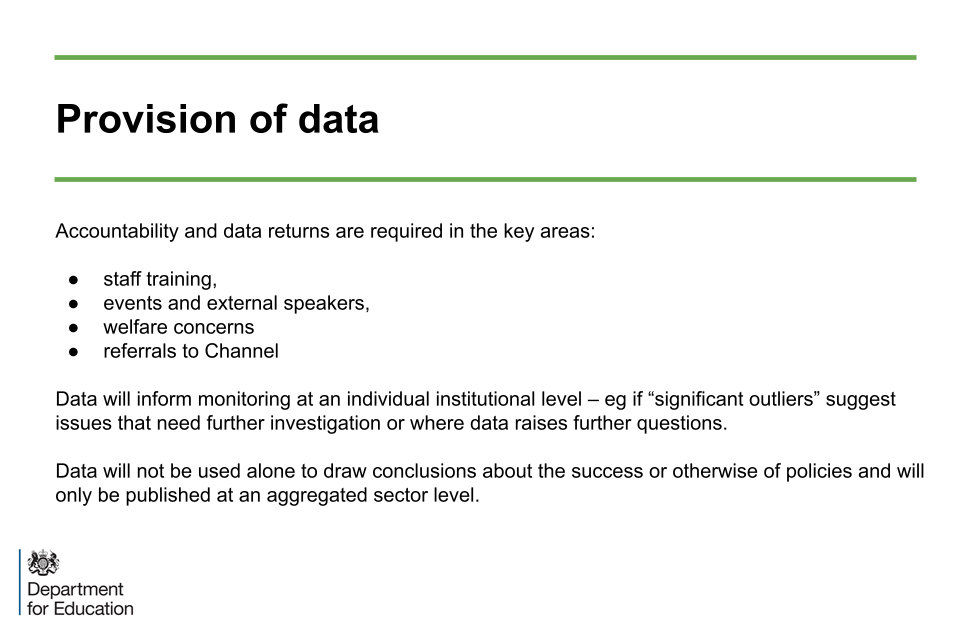
Image of slide 12: Provision of data
14. Reporting to government
The OfS will report on a periodic basis to the Department for Education and will publish relevant information and data; this may include aggregate figures on compliance across the sector, sector-level feedback on the monitoring process, and highlighting effective practice and areas for further consideration by all providers. The OfS may also share relevant information and data on individual providers’ implementation of the duty with government and other key Prevent partners on a need-to-know basis where necessary, including where a provider has been found not to be demonstrating due regard to the duty.

Image of slide 13: Reporting to government
15. Further support
As part of the OfS’s monitoring role, they support the sector through promoting an environment of continuous improvement. The OfS provides information and guidance in response to issues as they emerge, as well as anticipating potential issues and offering resources for providers to help mitigate potential risks on compliance at sector level.
There will be on ongoing programme of OfS work to include: a ‘What works’ programme to share effective practice: guidance and advice documents; anonymised case reviews to share learnings from serious incidents or material changes; and thematic reviews or ‘deep dives’ in areas where the OfS identifies a need for more assurance from the sector. The OfS are committed to evaluating the effectiveness of this monitoring framework and of the OfS’s role as the monitoring body and will work in consultation with government, the sector, sector representatives and students, to ensure it remains fit for purpose.
Further information is available from the OfS and further guidance can also be accessed through the network of the Department for Education’s FE and HE Prevent co-ordinators. Further information for Wales is available. RHEBs in Scotland should contact local multi-agency CONTEST groups and the national Prevent and CONTEST governance structures for support.
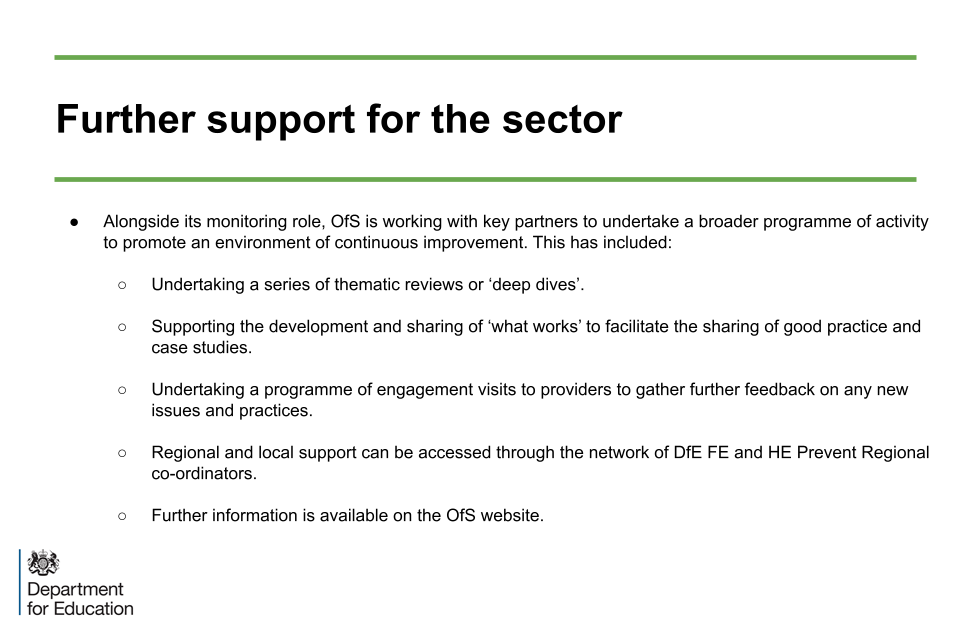
Image of slide 14: Further support for the sector
16. Summary
The following are vital for effective implementation of the Prevent Duty:
- Clear leadership
- Proportionality and perspective
- Clear policies and procedures
- Transparency and good communication
- Partnership with stakeholders internally and externally
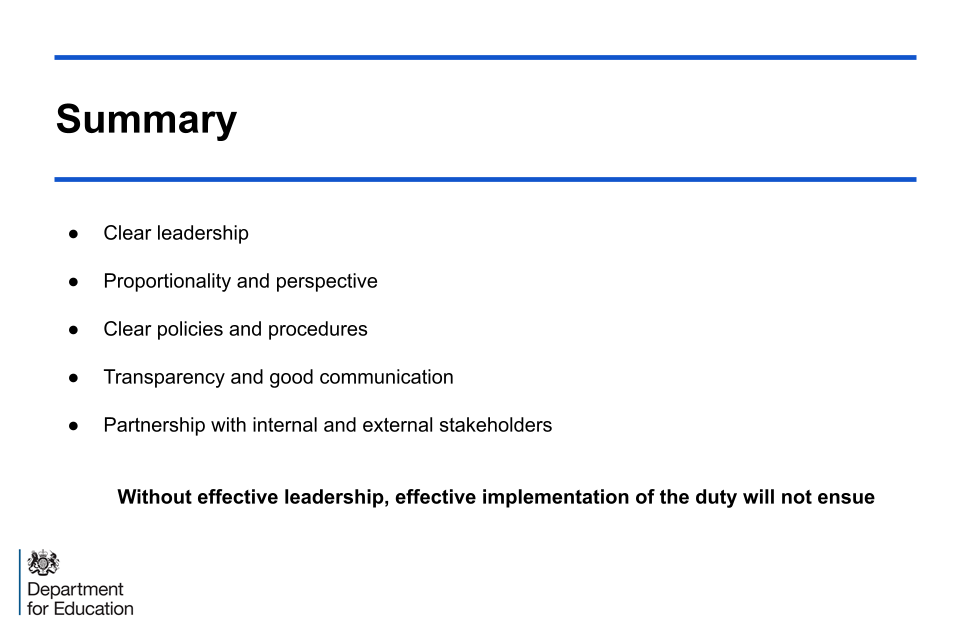
Image of slide 15: Summary
